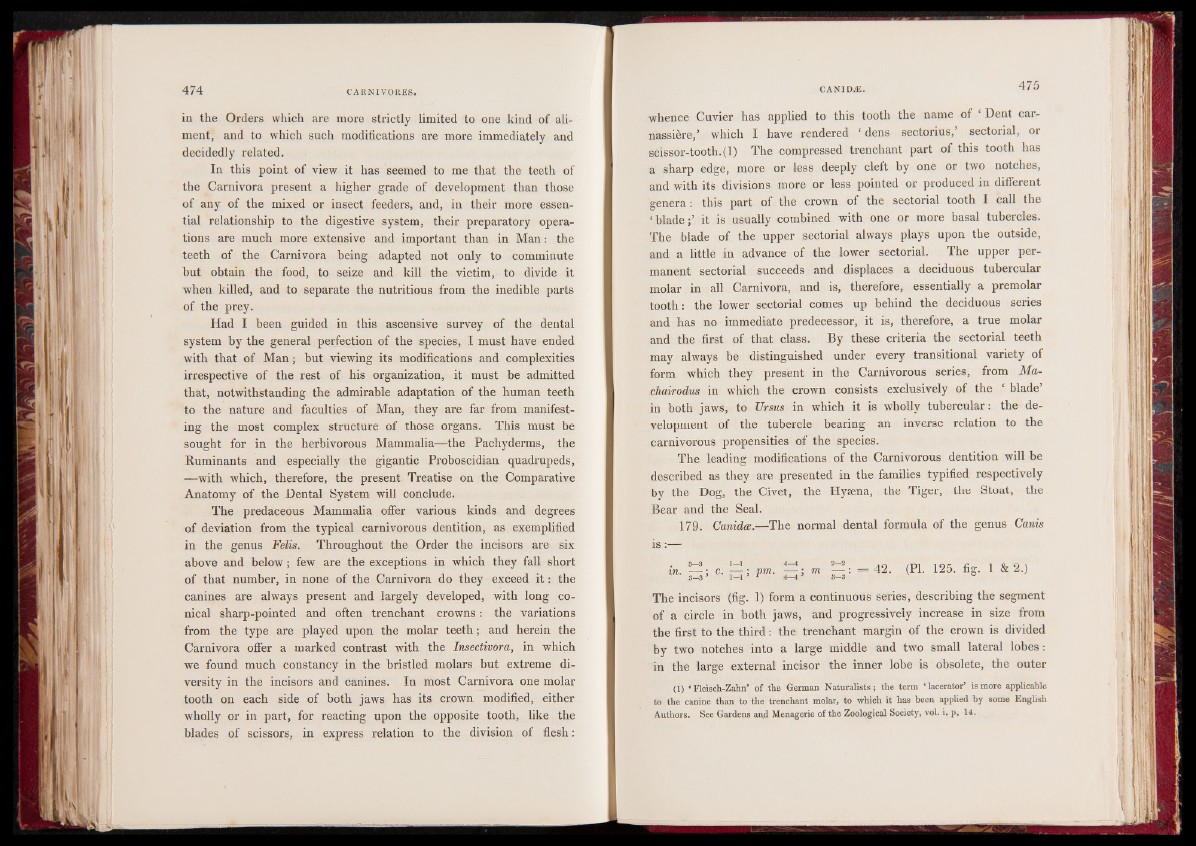
in the Orders which are more strictly limited to one kind of aliment,
and to which such modifications are more immediately and
decidedly related.
In this point of view it has seemed to me that the teeth of
the Carnivora present a higher grade of development than those
of any of the mixed or insect feeders, and, in their more essential
relationship to the digestive system, their preparatory operations
are much more extensive and important than in Man: the
teeth of the Carnivora being adapted not only to comminute
but obtain the food, to seize and kill the victim, to divide it
when killed, and to separate the nutritious from the inedible parts
of the prey.
Had I been guided in this ascensive survey of the dental
system by the general perfection of the species, I must have ended
with that of Man; but viewing its modifications and complexities
irrespective of the rest of his organization, it must be admitted
that, notwithstanding the admirable adaptation of the human teeth
to the nature and faculties of Man, they are far from manifesting
the most complex structure of those organs. This must be
sought for in the herbivorous Mammalia—the Pachyderms, the
Ruminants and especially the gigantic Proboscidian quadrupeds,
—with which, therefore, the present Treatise on the Comparative
Anatomy of the Dental System will conclude.
The predaceous Mammalia offer various kinds and degrees
of deviation from the typical carnivorous dentition, as exemplified
in the genus Felis. Throughout the Order the incisors are six
above and below; few are the exceptions in which they fall short
of that number, in none of the Carnivora do they exceed i t : the
canines are always present and largely developed, with long conical
sharp-pointed and often trenchant crowns: the variations
from the type are played upon the molar teeth; and herein the
Carnivora offer a marked contrast with the Insectivora, in which
we found much constancy in the bristled molars but extreme diversity
in the incisors and canines. In most Carnivora one molar
tooth on each side of both jaws has its crown modified, either
wholly or in part, for reacting upon the opposite tooth, like the
blades of scissors, in express relation to the division of flesh:
whence Cuvier has applied to this tooth the name of ‘ Dent carnassière,’
which I have rendered ‘ dens sectorius,’ sectorial, or
scissor-tooth.(l) The compressed trenchant part of this tooth has
a sharp edge, more or less deeply cleft by one or two notches,
and with its divisions more or less pointed or produced in different
genera : this part of the crown of the sectorial tooth I call the
‘blade;’ it is usually combined with one or more basal tubercles.
The blade of the upper sectorial always plays upon the outside,
and a little in advance of the lower sectorial. The upper permanent
sectorial succeeds and displaces a deciduous tubercular
molar in all Carnivora, and is, therefore, essentially a premolar
tooth: the lower sectorial comes up behind the deciduous series
and has no immediate predecessor, it is, therefore, a true molar
and the first of that class. By these criteria the sectorial teeth
may always be distinguished under every transitional variety of
form which they present in the Carnivorous series, from Ma-
chairodus in which the crown consists exclusively of the ‘ blade’
in both jaws, to Ursus in which it is wholly tubercular: the development
of the tubercle bearing an inverse relation to the
carnivorous propensities of the species.
The leading modifications of the Carnivorous dentition will be
described as they are presented in the families typified respectively
by the Dog, the Civet, the Hyæna, the Tiger, the Stoat, the
Bear and the Seal.
179. Canidæ.—The normal dental formula of the genus Canis
is :—
in. 8—3
3—3 §
|« 1S—1B ; pm. 4—4
4—4 9 m — : = 42. 3—3 (PI. 125. fig. 1 & 2.)
The incisors (fig. 1) form a continuous series, describing the segment
of a circle in both jaws, and progressively increase in size from
the first to the third: the trenchant margin of the crown is divided
by two notches into a large middle and two small lateral lobes:
in the large external incisor the inner lobe is obsolete, the outer
(1) ' Fleisch-Zahn’ of the German Naturalists; the term ‘lacerator’ is more applicable
to the canine than to the trenchant molar, to which it has been applied by some English
Authors. See Gardens and Menagerie of the Zoological Society, vol. i. p, 14.